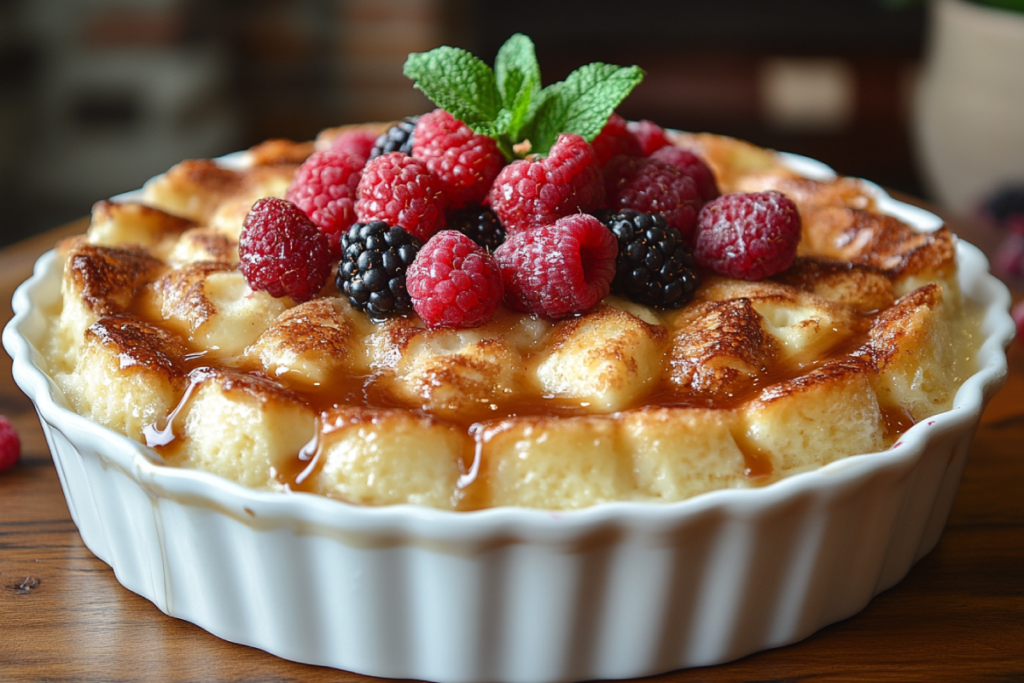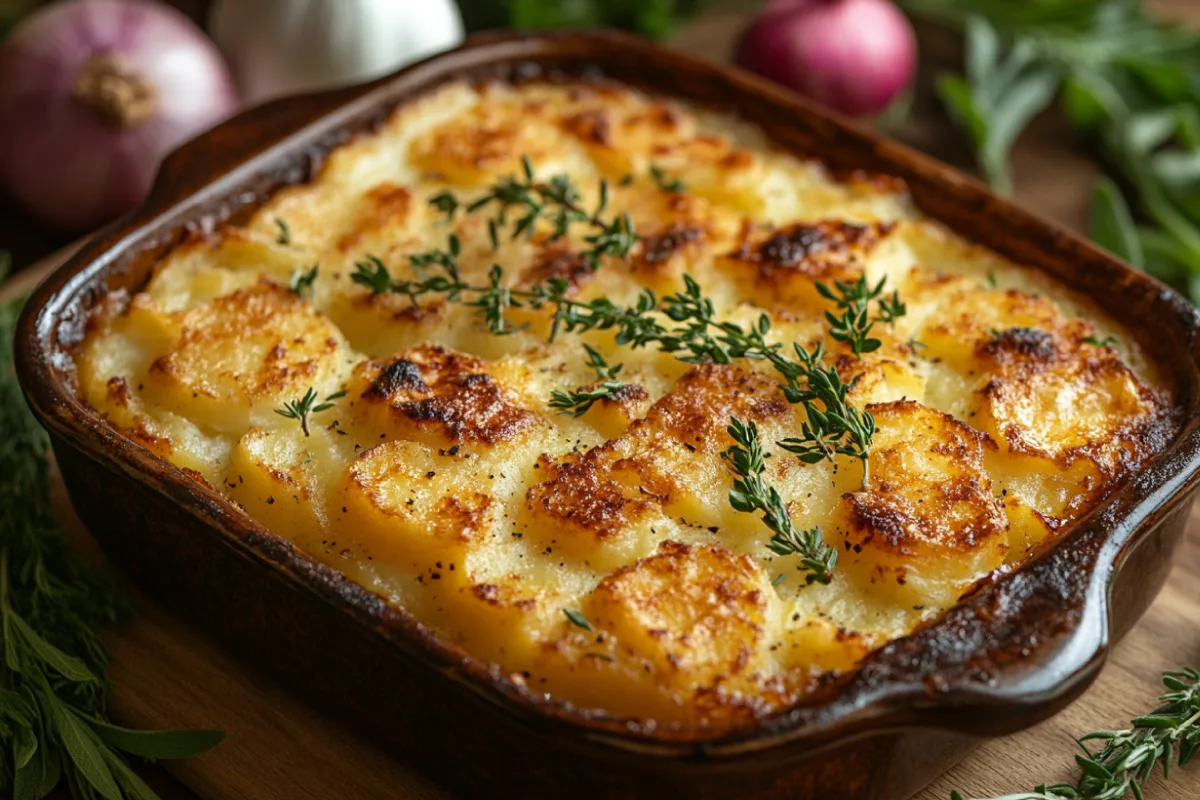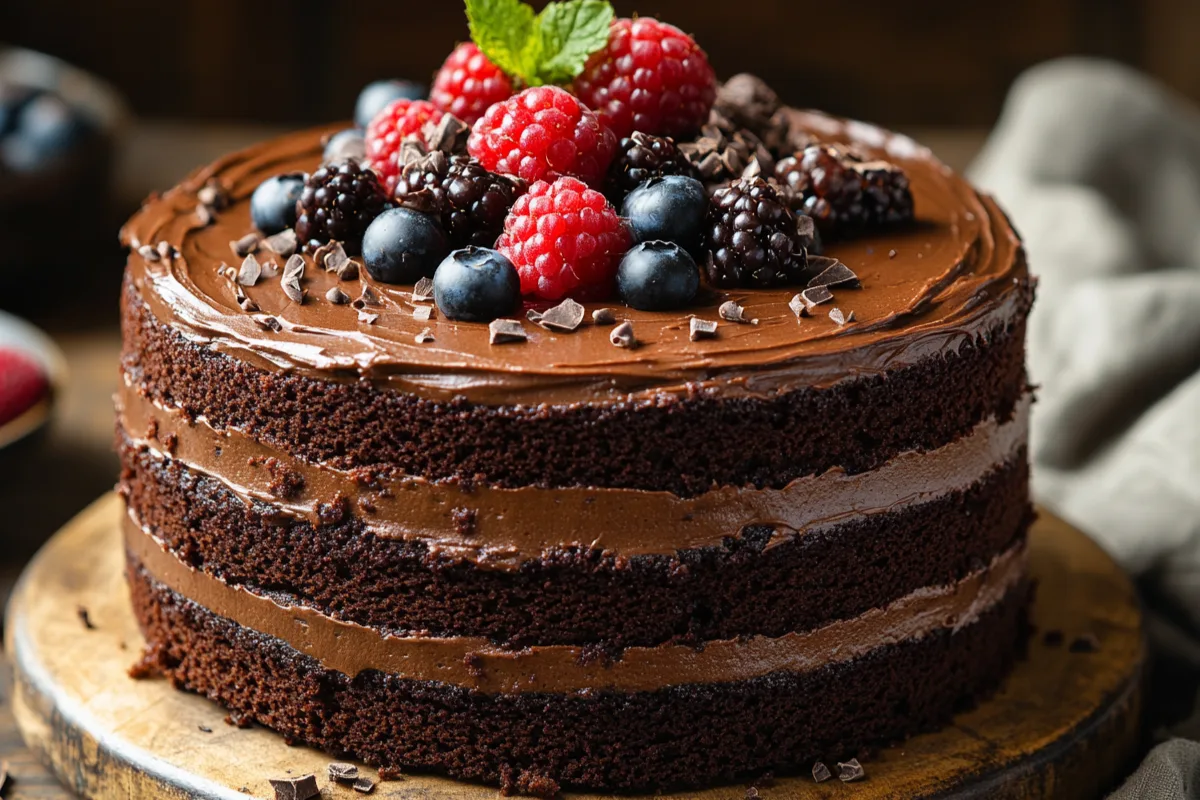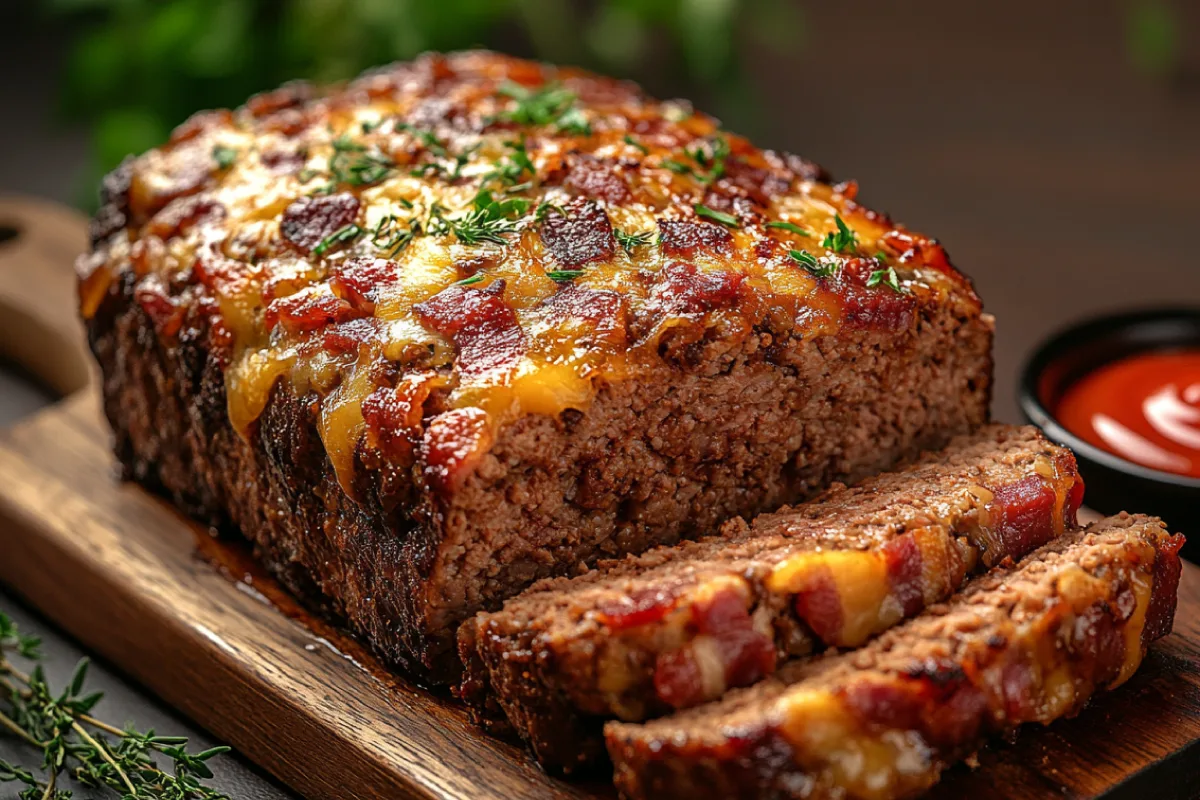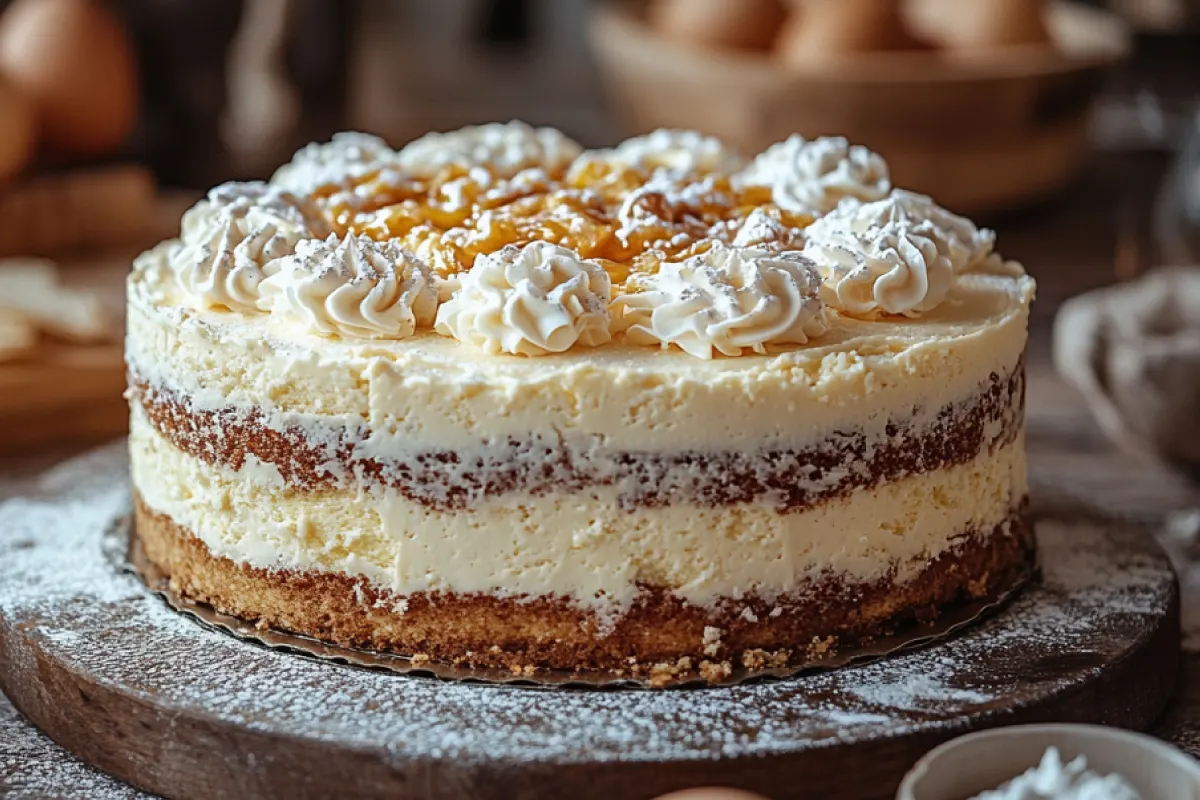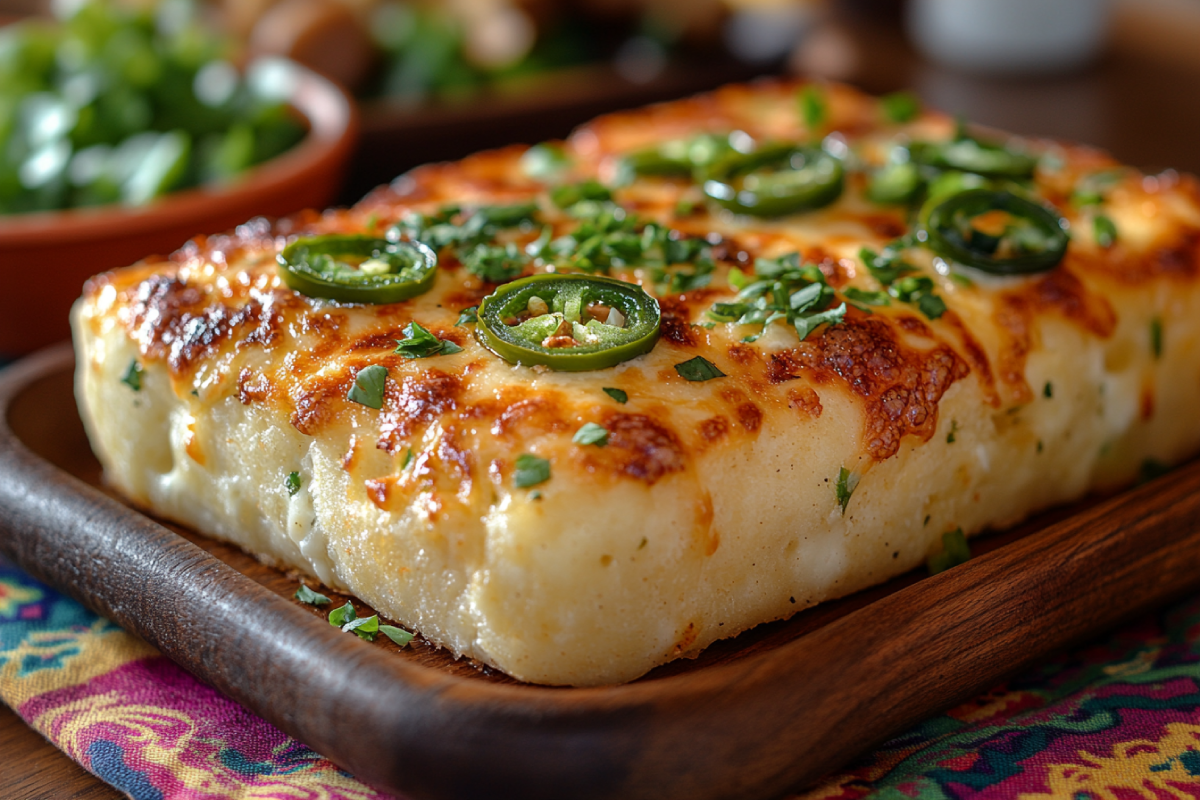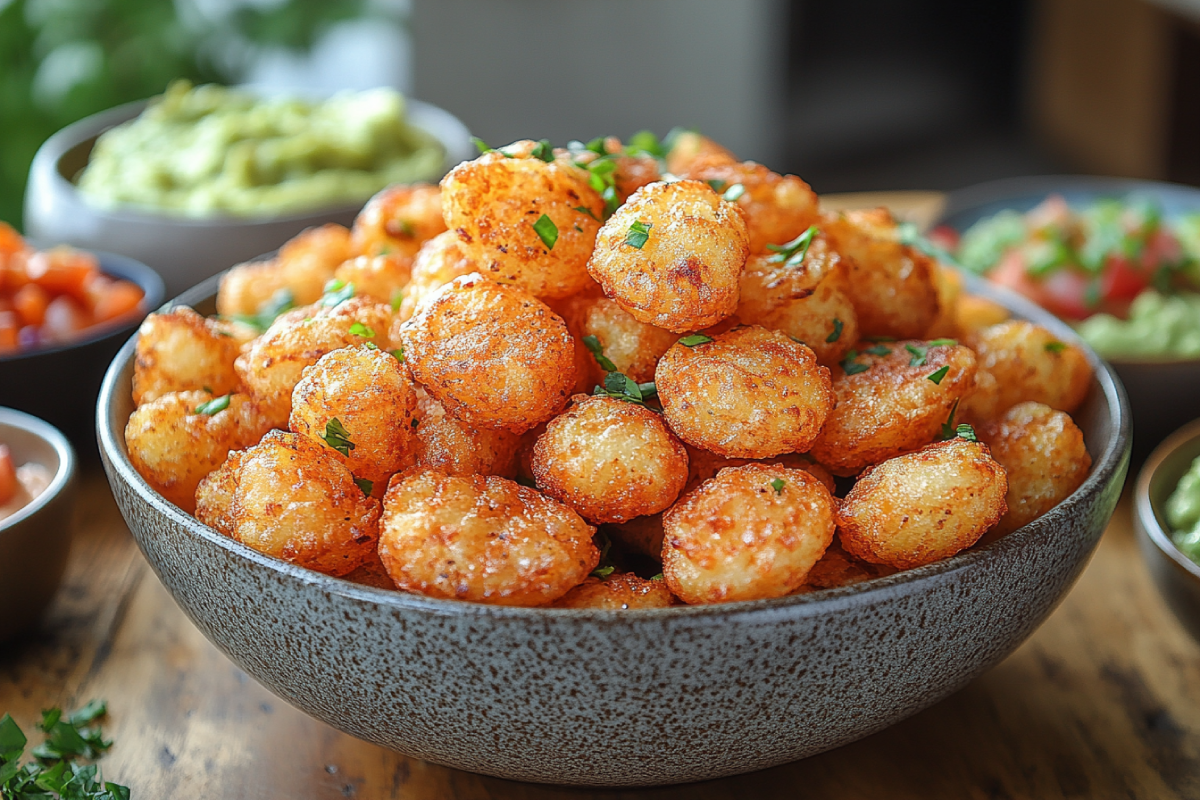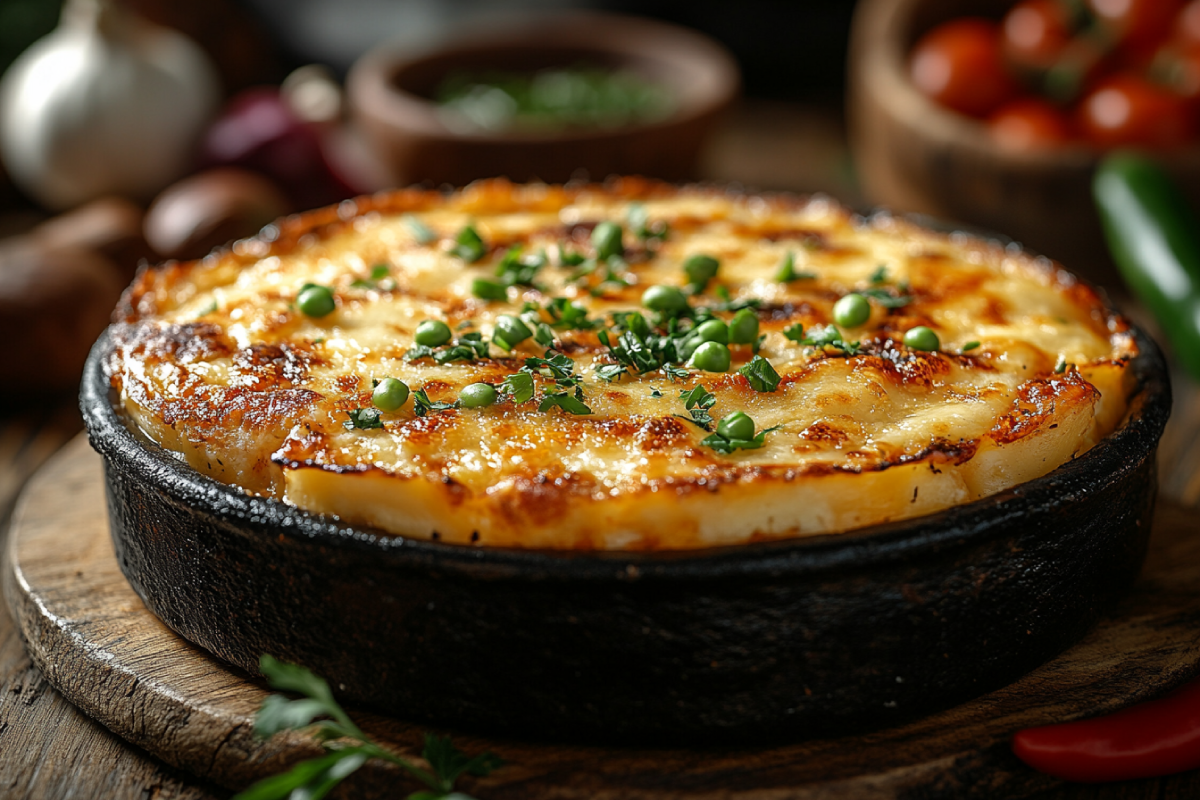White chocolate bread pudding is a decadent dessert that combines the comforting texture of classic bread pudding with the creamy sweetness of white chocolate. This treat is beloved for its rich flavor, easy preparation, and the ability to elevate simple ingredients into a gourmet experience. Whether served warm with a drizzle of sauce or cold as a midday indulgence, white chocolate bread pudding is a versatile dish that delights in every bite.
Bread pudding has been a favorite dessert for centuries, and the addition of white chocolate offers a modern twist to this traditional recipe. In this article, we will explore everything you need to know to create the perfect white chocolate bread pudding, from its history and key ingredients to step-by-step preparation techniques and serving ideas.
What is Bread Pudding?
History of Bread Pudding
Bread pudding dates back centuries, originating as a practical way to use stale bread and avoid food waste. In medieval Europe, it was often called “poor man’s pudding” because it transformed leftover bread into a hearty dish. By soaking bread in a mixture of milk, eggs, and sugar, bakers created a dessert that was both economical and satisfying. Over time, bread pudding evolved into a beloved dish, with variations appearing in cuisines worldwide.
Evolution of Bread Pudding Recipes
While the classic bread pudding recipe remains popular, modern adaptations incorporate a variety of ingredients to enhance flavor and texture. Today, bread pudding can include fruits, spices, chocolate, and even savory elements. White chocolate bread pudding exemplifies this evolution, offering a luxurious take on the traditional dessert by introducing the creamy, sweet notes of white chocolate.
Why White Chocolate Bread Pudding is Unique
White chocolate bread pudding stands out for its balance of rich, buttery sweetness and soft, custard-soaked bread. Unlike darker chocolates, which have a more intense cocoa flavor, white chocolate provides a milder taste that pairs beautifully with vanilla, caramel, or even citrus. Its smooth texture melts seamlessly into the custard, creating a dessert that feels indulgent yet light.
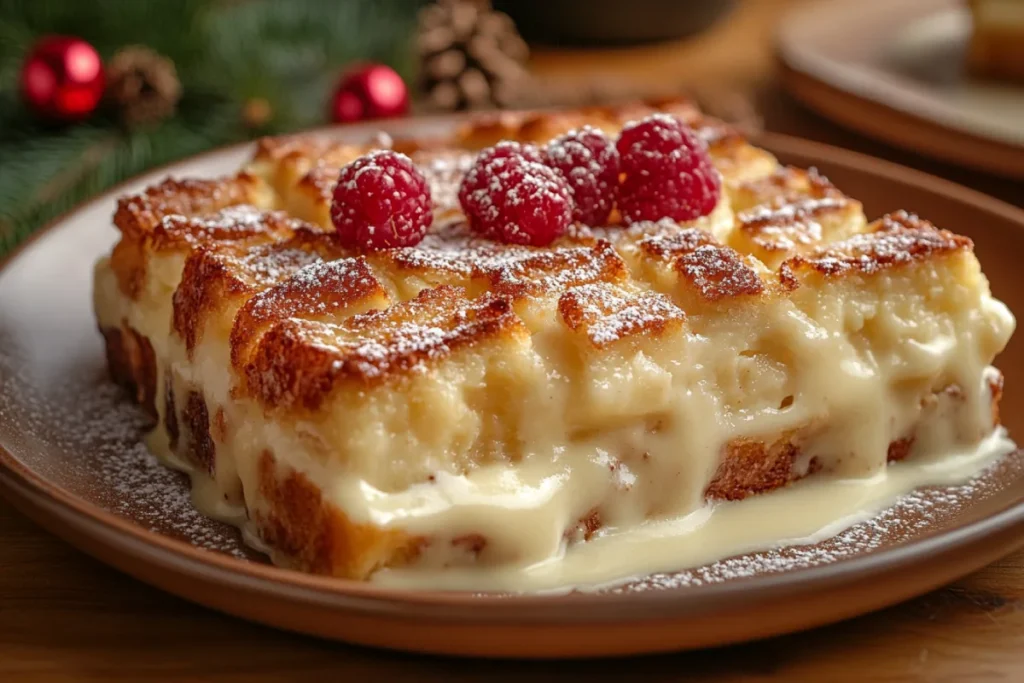
Ingredients for White Chocolate Bread Pudding
Selecting the Right Bread
The foundation of any bread pudding is, of course, the bread. For the best results, choose a bread with a sturdy structure and the ability to soak up the custard without falling apart. Popular options include:
- Brioche: Its buttery, rich flavor complements the sweetness of the pudding.
- Challah: Slightly sweet and tender, challah is another excellent choice.
- French Bread: With its firm crust and soft interior, it holds up well to soaking.
Stale or day-old bread is ideal, as it absorbs the custard more effectively than fresh bread.
Types of White Chocolate
Not all white chocolate is created equal. To achieve the best flavor and texture, look for high-quality white chocolate with a cocoa butter content of at least 20%. Avoid white chocolate that relies on artificial ingredients or palm oil, as these can result in a less creamy finish. You can use:
- White chocolate chips for convenience.
- White chocolate bars for a richer, more artisanal taste.
- White chocolate chunks for pockets of melty sweetness in the pudding.
Additional Flavors and Enhancements
While white chocolate is the star of this dish, complementary flavors can elevate your pudding. Consider incorporating:
- Vanilla extract: Enhances the overall sweetness and aroma.
- Spices: Cinnamon or nutmeg can add warmth and depth.
- Fruits: Fresh berries or dried cranberries provide bursts of tartness.
- Liquors: A splash of amaretto or bourbon can add a sophisticated twist.
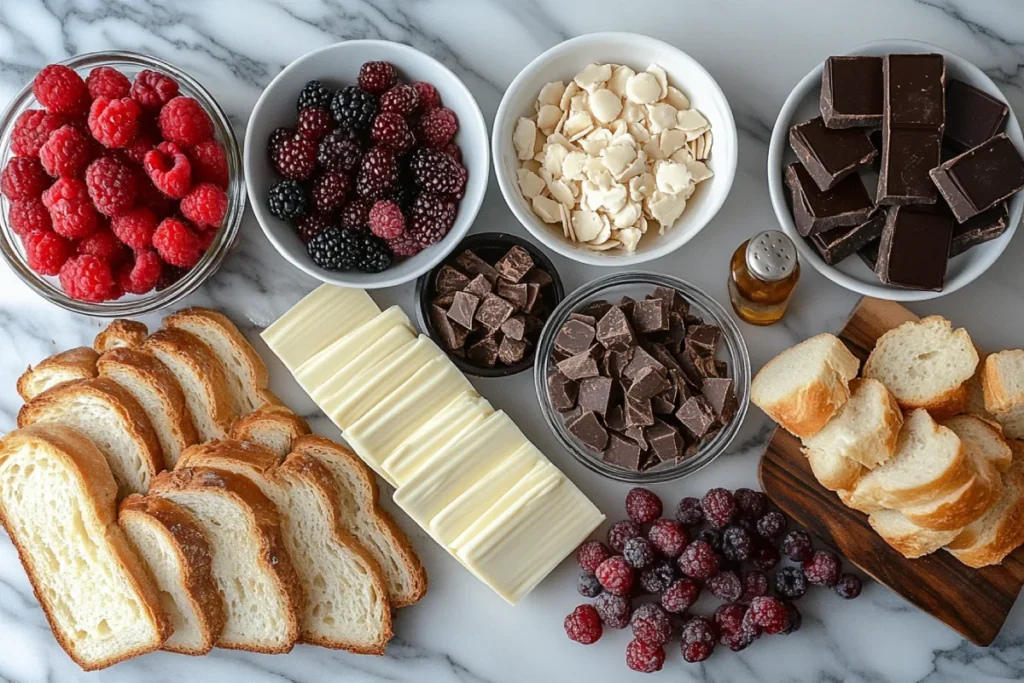
Step-by-Step Recipe
Preparing the Bread
- Cut the Bread: Slice the bread into 1-inch cubes for even soaking.
- Toast if Necessary: If your bread isn’t stale, lightly toast the cubes in the oven to dry them out. This step ensures they will absorb the custard fully.
- Arrange in the Pan: Spread the bread evenly in a greased baking dish to ensure a uniform bake.
Making the Custard
- Combine Wet Ingredients: Whisk together eggs, heavy cream, whole milk, and sugar.
- Incorporate White Chocolate: Melt white chocolate and mix it into the custard for a creamy base.
- Add Flavorings: Stir in vanilla extract and any chosen spices or liquors.
Combining and Baking
- Soak the Bread: Pour the custard over the bread cubes, pressing gently to ensure even absorption. Let it sit for 20–30 minutes.
- Bake: Place the dish in a preheated oven at 350°F (175°C) and bake for 45–55 minutes, or until the top is golden brown and the custard is set.
- Cool: Allow the pudding to cool slightly before serving to enhance the flavors and texture.
Tips for Perfect Texture and Flavor
- Avoid Overmixing: Overmixing the custard can introduce air bubbles, resulting in a less creamy texture.
- Monitor Baking Time: Check for doneness by inserting a knife in the center; it should come out clean but moist.
- Customize Sweetness: Adjust the sugar content based on the sweetness of your white chocolate.
Serving and Presentation
Best Toppings for White Chocolate Bread Pudding
The right toppings can elevate white chocolate bread pudding to a restaurant-quality dessert. Here are some popular options to consider:
- White Chocolate Sauce: Drizzle melted white chocolate over the pudding for added richness.
- Caramel Sauce: A warm caramel drizzle complements the sweetness of the dish with a hint of buttery depth.
- Fresh Berries: Strawberries, raspberries, or blueberries add a tart contrast to the creamy pudding.
- Whipped Cream: A dollop of freshly whipped cream makes each bite lighter and fluffier.
- Crushed Nuts: Toasted almonds, pecans, or hazelnuts offer a satisfying crunch and nutty flavor.
Serving Suggestions
White chocolate bread pudding can be served warm, cold, or at room temperature. Here are a few serving ideas for different occasions:
- Warm with Ice Cream: Serve the pudding warm with a scoop of vanilla or salted caramel ice cream for an indulgent treat.
- Chilled for Brunch: Allow the pudding to cool completely and serve it as a brunch centerpiece, paired with fresh fruit.
- Mini Portions for Parties: Divide the pudding into ramekins or muffin tins for individual servings, perfect for gatherings.
Pairing with Drinks
Pairing the pudding with the right beverage enhances the experience. Some excellent options include:
- Coffee or Espresso: The bitterness of coffee balances the dessert’s sweetness.
- Sweet Dessert Wines: A glass of Moscato or a late-harvest Riesling complements the pudding beautifully.
- Hot Chocolate: For a cozy, indulgent pairing, serve with a cup of creamy hot chocolate.
Nutritional Information and Alternatives
Calories and Nutrient Breakdown
White chocolate bread pudding is a rich dessert, so portion control is key if you’re watching your calorie intake. Here’s an approximate nutritional profile per serving:
- Calories: 350–450 (varies based on portion size and ingredients)
- Carbohydrates: 40–50g
- Protein: 6–8g
- Fat: 18–25g
- Sugar: 20–30g
Healthier Variations and Substitutes
For a lighter version of this dessert, consider these substitutions:
- Bread: Use whole-grain bread or sourdough for added fiber and less refined flour.
- Milk and Cream: Replace heavy cream with low-fat milk or plant-based alternatives like almond or oat milk.
- Sweeteners: Substitute sugar with natural sweeteners like honey, maple syrup, or stevia.
- White Chocolate: Use a smaller amount of high-quality white chocolate to reduce sugar content.
You can also incorporate nutritious add-ins like chia seeds, nuts, or dried fruits to boost the dish’s nutritional value.
Why Choose White Chocolate Bread Pudding?
Versatility for Occasions
White chocolate bread pudding is an adaptable dessert suitable for various events. Whether you’re hosting a holiday dinner, attending a potluck, or preparing a special dessert for family, this dish is a guaranteed crowd-pleaser. Its versatility allows you to tailor the flavor profile to suit any season or celebration.
A Treat for All Ages
This dessert appeals to a wide range of tastes, making it perfect for gatherings with mixed age groups. Children will love its sweet, creamy texture, while adults can appreciate its sophisticated flavors, especially when paired with a rich sauce or complementary drink.
The Allure of White Chocolate Bread Pudding
White chocolate bread pudding has quickly gained a reputation for being a comfort food that transcends the typical dessert experience. It’s not just a treat; it’s a memorable part of a meal, whether you’re enjoying it at a family gathering, holiday celebration, or as a special indulgence on a quiet evening. Its delicate sweetness and creamy texture make it a standout, even among a variety of other desserts. One of the many reasons white chocolate bread pudding is so beloved is because it caters to a wide range of preferences.
Perfecting the Art of Bread Pudding
Making the perfect white chocolate bread pudding requires some attention to detail, but it’s easier than it may sound. The bread is the foundation, and choosing the right kind ensures the perfect texture. The custard mixture is where the magic happens. The balance between eggs, milk, sugar, and white chocolate must be just right to achieve that creamy, luscious filling that soaks into the bread.
When making the custard, you’ll want to be careful not to overheat the white chocolate as it can separate or become grainy. The process should be slow and steady, allowing the chocolate to melt into the custard evenly. Stirring in vanilla extract is a simple step that enhances the pudding’s depth of flavor, while cinnamon or nutmeg adds that comforting hint of spice.
Why Stale Bread Works Best
Using stale bread for white chocolate bread pudding is one of the most important tips for success. Fresh bread may be too soft to hold up to the custard mixture, leading to a mushy, less appealing texture. On the other hand, stale or day-old bread has had time to dry out, allowing it to soak up the custard and retain its shape as it bakes.
Brioche and challah are two of the best types of bread for this dish, but feel free to experiment with others. Croissants, with their flaky layers, can add a unique texture to the pudding, while sourdough will provide a bit of tang that contrasts beautifully with the sweetness of the white chocolate.
The Role of White Chocolate in the Pudding
While bread pudding recipes typically use dark or milk chocolate, the addition of white chocolate in this variation is what sets it apart. White chocolate is made from cocoa butter and sugar but lacks the cocoa solids found in other types of chocolate. This gives white chocolate a smooth, buttery flavor that pairs perfectly with the creamy custard.
To achieve the best result, choose high-quality white chocolate with at least 20% cocoa butter content. Lower-quality white chocolate may lack the creamy texture and could result in a less satisfying pudding. By using a premium product, you’re ensuring that the rich, silky texture of the pudding is as indulgent as possible.
Making White Chocolate Bread Pudding Your Own
One of the greatest things about white chocolate bread pudding is its adaptability. While the basic ingredients provide a delicious dessert on their own, there are endless ways to make it uniquely yours.
For example, you can add fruits like fresh berries or apples, which offer a refreshing burst of tartness. Dried fruits, such as raisins, cranberries, or apricots, can add natural sweetness and chewy texture. Nuts, like toasted almonds or walnuts, contribute crunch and depth of flavor. Adding liqueurs, such as amaretto, bourbon, or a splash of vanilla extract, can enhance the dessert’s complexity, creating layers of taste that linger on the palate.
Cooking and Serving Techniques
While the preparation of white chocolate bread pudding might seem straightforward, the baking process is where it really comes to life. The pudding needs to bake for about 45 to 55 minutes at 350°F (175°C), but it’s important to keep a close eye on it during the final stages. The custard should set without becoming too firm, and the top should achieve a light golden brown color.
If you find that your bread pudding is overbaking, cover it loosely with foil to prevent the top from becoming too dark while the custard finishes setting. On the other hand, if the top is not golden and the pudding is still too liquid, a few extra minutes in the oven should do the trick.
Once your white chocolate bread pudding is baked to perfection, allow it to cool slightly to help it set and make serving easier. Whether served warm, at room temperature, or chilled, the pudding will retain its delightful creaminess and rich sweetness.
Serving Ideas and Pairings
White chocolate bread pudding is delicious on its own, but with the right accompaniment, it can become an extraordinary dessert experience. Consider adding a dollop of freshly whipped cream or a scoop of vanilla ice cream to cool down the richness of the pudding. A drizzle of white chocolate or caramel sauce can add extra indulgence, while fresh fruit like berries provides a refreshing contrast.
For a more luxurious presentation, top the pudding with a handful of crushed toasted nuts, such as hazelnuts or pecans. The crunch complements the pudding’s creamy texture and adds an extra layer of flavor.
The Ideal Beverage Pairings
Beverages can significantly enhance the dessert experience, and white chocolate bread pudding pairs wonderfully with a variety of drinks. If you prefer a hot beverage, a freshly brewed cup of coffee or espresso is an excellent choice. The bitterness of the coffee contrasts perfectly with the sweetness of the bread pudding. For something more indulgent, pair it with a cup of hot chocolate, where the chocolate’s richness complements the dessert’s smooth creaminess.
For a more sophisticated pairing, serve white chocolate bread pudding with a glass of dessert wine. A sweet, aromatic Moscato or a late-harvest Riesling balances the pudding’s richness while adding another layer of complexity to the meal.
Storing and Reheating Leftovers
If you find yourself with leftovers, white chocolate bread pudding can be stored in the fridge for up to three days. The flavor often improves as it sits, allowing the custard to continue soaking into the bread. When reheating, you can use the oven, microwave, or stovetop. For the best results, reheat individual portions in the oven at 325°F (160°C) for 15 to 20 minutes, ensuring they are heated through without drying out.
Alternatively, if you prefer to freeze the pudding, it can be wrapped tightly and stored in the freezer for up to three months. To reheat frozen bread pudding, simply thaw it in the refrigerator overnight and bake it at 325°F (160°C) until heated through.
FAQ
Heading 3: Can I Use Dark Chocolate Instead of White Chocolate?
Yes, you can substitute white chocolate with dark chocolate if you prefer a richer, more robust flavor. Keep in mind that dark chocolate has a more pronounced cocoa taste and less sweetness than white chocolate. Adjust the sugar in the recipe accordingly to maintain balance.
Heading 3: What’s the Best Bread for Bread Pudding?
The best bread for bread pudding is one with a sturdy structure that can absorb the custard without falling apart. Brioche, challah, and French bread are top choices, but you can also use croissants, sourdough, or even leftover dinner rolls. Avoid bread that is overly soft or delicate, as it may disintegrate during soaking.
Heading 3: Can Bread Pudding Be Made in Advance?
Absolutely! You can prepare bread pudding a day ahead of time by assembling the dish and refrigerating it before baking. When ready to serve, bake it fresh or reheat it in the oven to warm through. This method is convenient for parties or busy schedules.
Heading 3: How to Reheat Bread Pudding Without Losing Texture?
To reheat bread pudding while retaining its creamy texture, follow these tips:
- Oven Method: Cover the pudding with foil and heat at 325°F (160°C) for 15–20 minutes.
- Microwave Method: Reheat individual portions on medium power for 30–60 seconds.
- Add Moisture: If the pudding seems dry, add a splash of milk or cream before reheating.
Heading 3: Is White Chocolate Bread Pudding Freezer-Friendly?
Yes, white chocolate bread pudding can be frozen for up to three months. To freeze:
- Allow the pudding to cool completely.
- Wrap it tightly in plastic wrap and foil, or place it in an airtight container.
- Thaw in the refrigerator overnight and reheat before serving.
Heading 3: Can I Add Fruits or Nuts?
Certainly! Fruits and nuts are excellent additions to white chocolate bread pudding. Popular choices include:
- Fruits: Fresh berries, sliced bananas, or dried fruits like raisins and apricots.
- Nuts: Chopped pecans, walnuts, or slivered almonds add crunch and flavor.
When adding fruits, be mindful of their moisture content, as it may slightly alter the custard consistency.
Table of Contents
Conclusion
White chocolate bread pudding is a delightful dessert that combines the timeless charm of traditional bread pudding with the luxurious sweetness of white chocolate. Its versatility, ease of preparation, and potential for creative customization make it a go-to recipe for home cooks and professional chefs alike.
Whether you’re preparing it for a special occasion, a cozy family dinner, or simply to satisfy your sweet tooth, this dessert promises to impress. By using high-quality ingredients and following the tips outlined in this guide, you can create a dish that is both comforting and elegant. So, grab your favorite bread, melt some white chocolate, and dive into the world of creamy, custardy perfection. Your taste buds will thank you!

